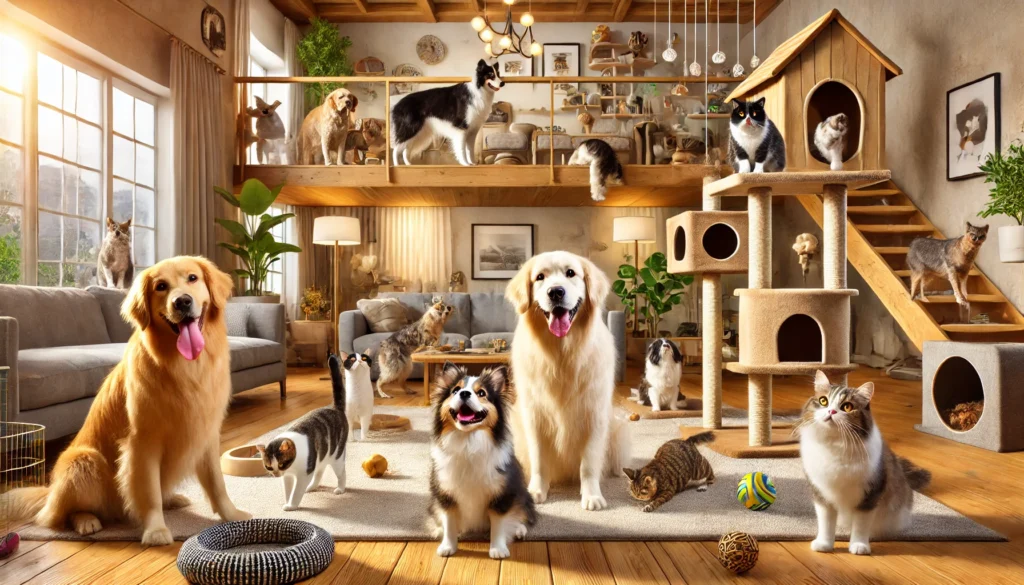Dogs and cats are the two most popular pets around the world — but while they can share your home, their daily care needs are very different. From grooming to exercise to emotional connection, understanding these differences is key to providing the best care for each species.
Whether you have a dog, a cat, or both, here’s what you need to know about the unique routines and needs of each.
1. Feeding Habits
Dogs and cats eat differently — in frequency, preference, and style.
🦴 Dogs:
- Typically eat 1–2 meals a day.
- Tend to eat quickly and enthusiastically.
- Can adapt to a feeding schedule easily.
- Can eat a variety of foods including some vegetables and grains.
🐟 Cats:
- Prefer small, frequent meals throughout the day.
- Are more selective and sensitive to changes in food.
- Are obligate carnivores and need higher levels of animal protein.
- Don’t tolerate fasting well — even missing one meal can be a concern.
Tip: Dogs thrive on structure; cats thrive on autonomy.
2. Water Intake
Hydration looks different too — and can be more difficult to manage in cats.
🦴 Dogs:
- Drink readily from a bowl.
- Need more water due to panting and exercise.
- Will typically self-regulate their water intake.
🐟 Cats:
- Tend to drink less overall — especially if on dry food.
- Prefer running water (which is why many enjoy fountains).
- May need encouragement to stay hydrated.
Tip: For cats, adding wet food or broth to meals can improve hydration.
3. Bathroom Routines
Bathroom habits are one of the clearest differences in day-to-day care.
🦴 Dogs:
- Need to be taken outside multiple times a day.
- Often follow a routine: morning, midday, evening, and before bed.
- Require patience and consistency during house training.
🐟 Cats:
- Use a litter box that should be scooped daily.
- Are naturally inclined to bury waste, making litter box training easier.
- May develop behavioral issues if the litter box is dirty or poorly located.
Tip: Dogs require your active participation in their bathroom routine; cats demand cleanliness and privacy.
4. Grooming Needs
While both dogs and cats benefit from grooming, their requirements vary.
🦴 Dogs:
- Need regular brushing based on coat type (short, long, or double-coated).
- Often require nail trims, ear cleaning, and professional grooming.
- Typically tolerate or enjoy grooming if introduced properly.
🐟 Cats:
- Groom themselves frequently.
- Still need weekly brushing (daily for long-haired cats).
- May resist grooming if not used to being handled.
Tip: Grooming a cat may require more patience — but both species benefit from the bonding it provides.
5. Exercise and Stimulation
Both dogs and cats need physical and mental stimulation — but in very different ways.
🦴 Dogs:
- Require daily walks, playtime, and human interaction.
- Enjoy training sessions and games like fetch or agility.
- Often need more social interaction to feel fulfilled.
🐟 Cats:
- Rely more on solo or short burst play.
- Need climbing spaces, scratching posts, and puzzle toys.
- Are more independent, but still need stimulation to avoid boredom.
Tip: Dogs need you to participate in their activity; cats often prefer to engage on their own terms.
6. Social Behavior
Dogs and cats have completely different personalities when it comes to companionship.
🦴 Dogs:
- Pack animals by nature — thrive on companionship.
- Love following routines and spending time with their people.
- Often experience separation anxiety if left alone too long.
🐟 Cats:
- More solitary and territorial.
- Can be affectionate but prefer interactions when they choose.
- May be fine alone for longer periods but still enjoy quiet companionship.
Tip: Dogs seek closeness; cats value control of their space.
7. Communication and Training
Both pets communicate in unique ways — and respond differently to training.
🦴 Dogs:
- Learn commands and tricks easily with positive reinforcement.
- Communicate with barks, tail wagging, and body language.
- Training is a key part of their daily care.
🐟 Cats:
- Can learn basic commands and tricks, but at their own pace.
- Communicate through purring, meowing, and subtle body language.
- Are more sensitive to tone, timing, and stress.
Tip: Cats require softer, less repetitive training — while dogs benefit from structure and praise.
8. Health Monitoring
Dogs and cats show signs of illness differently.
🦴 Dogs:
- More likely to show pain or discomfort.
- Often alert owners by acting differently or seeking help.
- Benefit from routine vet checkups and vaccines.
🐟 Cats:
- Masters of hiding discomfort or sickness.
- Small behavioral changes (like hiding or eating less) can indicate illness.
- Require vigilant observation and proactive care.
Tip: Regular vet visits and daily observation are essential for both — but cats especially need you to notice subtle cues.
Final Thoughts: Respect the Differences
While dogs and cats share your home, they live very different daily experiences. Understanding their distinct needs helps you care for them more effectively, build stronger bonds, and prevent stress or health issues.
Embrace their personalities, give them space when they need it, and show them love in the way that suits them best. Your dog may want a walk and a belly rub — your cat may just want a warm bed near a sunny window.
Different species, different styles — same unconditional love.






